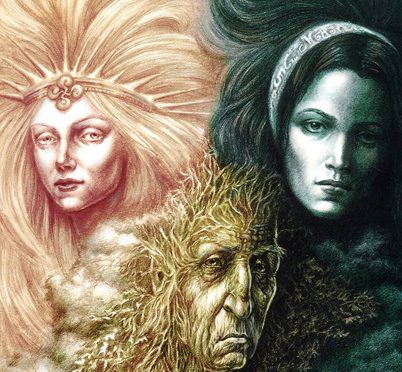Basque mythology can be a bit daunting to delve in to. The problem is that not much was written down and the bits we do have – much thanks to amazing ethnographers such as José Miguel de Barandiaran Ayerbe – are tangled threads of stories where characters and themes have merged and split many times, resulting in a mishmash of ideas. This is certainly the case with Amalur. Often conflated with Mari, she does seem to be a distinct entity in some stories. While both are Mother Earth figures, Amalur is the mother of the sun and the moon while Mari has Sugaar as her consort. We may never really know what prehistoric Basques really believed about the cosmos around them, but through the work of people like Barandiaran, we know more than we might have.

- Amalur, Ama Lur, or Ama Lurra all literally mean “Mother Earth” in Basque. Legend has it that Amalur first created the moon, Ilargi, as a way of scaring away monsters that were harassing people. However, the monsters soon became used to the light of the moon and came back to bother people. They again pleaded with Amalur to help, so she created Eguzki, the sun. And this worked – the monsters stayed away, at least when the sun was out. But at night, the monsters again returned. Once more, the people pleaded for help and this time Amalur created the Eguzkilore, literally the “sun flower,” which people could pick and put on their doors to keep the monsters away at all times.
- Thus, by helping out the humans that pleaded to her, Amalur is the mother of the sisters the sun and the moon, who each return to her each day as the other leaves.
- Amalur is a giant vessel that contains the power of life, making it so plants and animals can exist. She also contains vast treasure, and people often delve deep into caves searching for that treasure, though without ever finding it. People would leave coins behind in caves as an offering to Amalur, in the hope that she might favor them.
- Amalur and Mari are often confused in stories, making it hard to distinguish the two. They may simply be the same deity, the same mother goddess, or they may be distinct personifications of Mother Earth. Amalur as a name for this goddess is relatively new, perhaps coined by Nestor Basterretxea and Fernando Larrukert in their 1968 film Ama Lur. Whether they coined the name or not, it seems that their film made the name popular. What seems clear, however, is that the Basques of the Roman times worshipped a mother goddess. In Pamplona, there is an inscription on an alter with the words “MAtri Deae,” or Magna Mater, the Great Mother.
- In some interpretations, Amalur, or the Earth, contains everything, is everything, while Mari, as the personification of the energies and the forces that circulate throughout the world and all living beings, is her soul, in some sense.
- When the Romans came to the Iberian peninsula, their own goddess Cybele (“imported” from other cultures), also a mother goddess, might have been mixed with Mari/Amalur. Separating all of these different personas becomes quite challenging. Mari, in an incarnation closer to Amalur, has been described as dressed elegantly and carrying a golden palace in her hand. Cybele has been described similarly in other contexts.
- You can visit some of the most important sites related to Mari/Amalur with this map as a guide.
Primary sources: Amalur, Wikipedia; Eguzkilore: The Flower that Protects the Basques, About Basque Country; La Mitología Vasco en la Actualidad, Luis Garagalza, KOBIE (Serie Antropología Cultural). Bilbao
Bizkaiko Foru Aldundia-Diputación Foral de Bizkaia N.° XII, pp. 135 a 148, año 2006/7.


